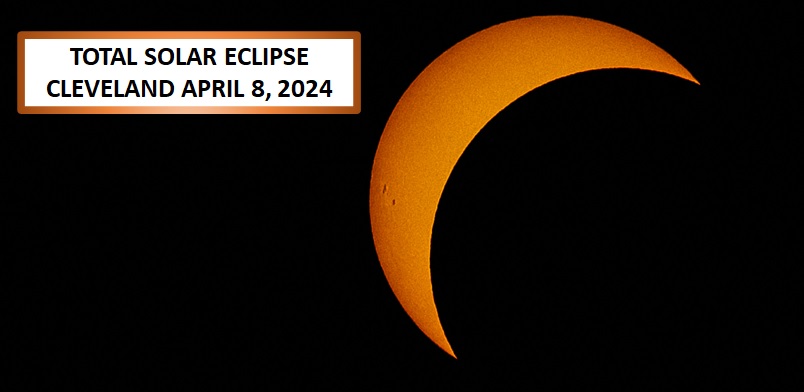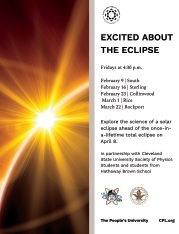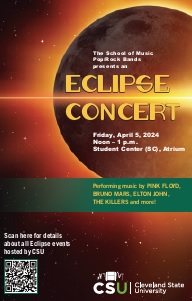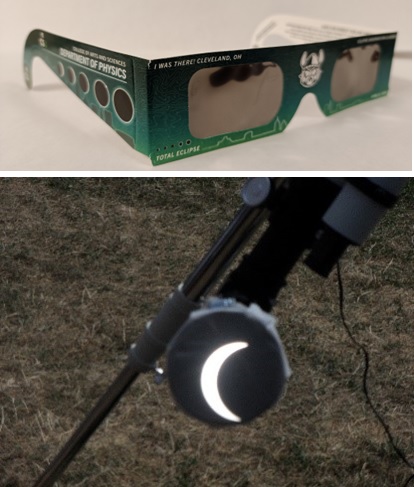Physics
Mailing Address
Cleveland State University
Department of Physics
2121 Euclid Avenue, PHY
Cleveland, OH 44115-2214
Campus Location
Science Building (SI)
2399 Euclid Avenue, Rm. 112
Contact Us
Phone: 216.687.2425
Fax: 216.523.7268
physics.dept@csuohio.edu
Total Solar Eclipse

IT'S A WRAP. WHAT A WONDERFUL DAY! CHECK OUT SOME GREAT MEMORIES AT THE FOLLOWING LINK:
https://artsandsciences.csuohio.edu/physics/its-wrap-some-nice-memories
 On April 8, 2024, a total solar eclipse will cross the North American continent, passing Mexico, the United States, and Canada. The eclipse will be unique, as over 31 million people live inside the path of totality and over half of the US population lives within 250 miles of it. Because this will be a total eclipse, at peak the Sun will be completely blocked (aside from the corona) and the sky will darken as if it were late dusk or early dawn. Major cities within the path of totality include: San Antonio, Austin, Dallas, Little Rock, Indianapolis, Buffalo, Niagara Falls, Montreal, and our own Cleveland.
On April 8, 2024, a total solar eclipse will cross the North American continent, passing Mexico, the United States, and Canada. The eclipse will be unique, as over 31 million people live inside the path of totality and over half of the US population lives within 250 miles of it. Because this will be a total eclipse, at peak the Sun will be completely blocked (aside from the corona) and the sky will darken as if it were late dusk or early dawn. Major cities within the path of totality include: San Antonio, Austin, Dallas, Little Rock, Indianapolis, Buffalo, Niagara Falls, Montreal, and our own Cleveland.
Where to Find Us – Department Activities
 Leading to and during the eclipse the Cleveland State University Physics Department will be involved in various eclipse-related activities as follows:
Leading to and during the eclipse the Cleveland State University Physics Department will be involved in various eclipse-related activities as follows:
- Booth at the Total Eclipse Fest 2024, April 6th – 8th - a partnership of the Great Lakes Science Center and the NASA Glenn Center: https://greatscience.com/explore/events-programs/total-eclipse-fest-2024 (coordinated by Petru Fodor, Tara Peppard and Miroslav Bogdanovski with participation from Andy Resnick, Alex Borisov and Sebastian Sensale Rodriguez)
- Eclipse Seminar Series (organized by Kiril Streletzky, Petru Fodor, and the Society of Physics Students):
| Date | Place | Speaker | Title |
|---|---|---|---|
| Tuesday, February 6, 2024, 11:30 am | SR 151 | Ygal Kaufman, Ideastream Public Radio | The Eclipse and Film |
| Thursday, February 29, 2024, 11:30 am | BH 202 | Adam Sonstegard, Cleveland State University, English | How a Graphic Novelist Almost Eclipsed Mark Twain |
| Tuesday, March 19, 2024, 11:30 am | SR 151 | Andrew Resnick, Cleveland State University, Physics |
Eclipse Photography (abstract, presentation, video) |
| Tuesday, April 2, 2024, 11:30 am | SR 151 | Timothy Dolch, Hillsdale College, Physics | Student-Driven Radio Observations of the Sun and the Ionosphere During the 2024 Total Solar Eclipse |
| Tuesday, April 9, 11:30 am | SR 151 | Joseph Glaser, West Virginia University | NANOGrav - Discovering the Gravitational Hum of the Universe |
 Society of Physics Students (SPS) outreach in the Cleveland Public Libraries (CPL) supported by an SPS Marsh W. White Award (coordinated by Kiril Streletzky, SPS Advisor; Janna Mino, Hathaway Brown School; Tara Peppard, Physics Lab Operations Manager; Patrick Herron, Jordan Miller, Collin Douglas, Grace Miller, James Taton and many other SPS students; Bernadette Lemak, Marina Márquez, and Isabelle Rew, Cleveland Public Library)
Society of Physics Students (SPS) outreach in the Cleveland Public Libraries (CPL) supported by an SPS Marsh W. White Award (coordinated by Kiril Streletzky, SPS Advisor; Janna Mino, Hathaway Brown School; Tara Peppard, Physics Lab Operations Manager; Patrick Herron, Jordan Miller, Collin Douglas, Grace Miller, James Taton and many other SPS students; Bernadette Lemak, Marina Márquez, and Isabelle Rew, Cleveland Public Library)
| Date | Time | Location |
|---|---|---|
| Friday, February 2, 2024 | 3:30 pm - 5:30 pm | Hathaway Brown School - "First Sighting" - introduction of eclipse-based outreach to middle- and high-school students |
| Friday, February 9, 2024 | 3:30 pm - 5:30 pm |
South Branch, Cleveland Public Library - "Outreach Totality" - eclipse-related demonstrations for after-school programs, library staff, and the general public. |
| Friday, February 16, 2024 | 3:30 pm - 5:30 pm | Sterling Branch, Cleveland Public Library |
| Friday, February 23, 2024 | 3:30 pm - 5:30 pm | Collinwood Branch, Cleveland Public Library |
| Friday, March 1, 2024 | 3:30 pm - 5:30 pm | Rice Branch, Cleveland Public Library |
| Friday, March 22, 2024 | 3:30 pm - 5:30 pm | Rockport Branch, Cleveland Public Library |
 On Campus Observation Site in collaboration with the Society of Physics Students SPS Zone 7 – Monday, April 8th - see schedule below. Good places to observe the eclipse from campus can be found on the following posted CSU Campus Map. Make sure to follow all regulations and safety notices (coordinated by Kirils Streletzky and the CSU Society of Physics Students Officers)
On Campus Observation Site in collaboration with the Society of Physics Students SPS Zone 7 – Monday, April 8th - see schedule below. Good places to observe the eclipse from campus can be found on the following posted CSU Campus Map. Make sure to follow all regulations and safety notices (coordinated by Kirils Streletzky and the CSU Society of Physics Students Officers)
| TIME | LOCATION | |
|---|---|---|
| 11:00 - 11:30 am | SR Atrium | Coffee & Tea with CSU Students, Alumni, Faculty, and SPS students |
| 11:30 am - 12:20 pm | SR 151 |
Presentation: Dr. Thijs Heus (Associate Professor of Physics, Cleveland State University). Dr. Heus will talk about the weather and the eclipse. |
| 12:20 - 1:00pm | SR Atrium | Pizza lunch break |
| 1:00 - 1:50 pm | SR 151 |
Presentation: Dr. Joseph Glaser (Scientific Computing Specialist, NANOGrav, West Virginia University). Dr. Glaser will talk about the eclipse and the work of radio astronomers at the Geauga County Observatory Park. |
| 2:00 - 4:30 pm | Front of SR | Weather permitting, eclipse observation will occur outside (Telescope tent, Radio Observation tent). Eclipse live feeds from NASA [SR 152] and SPS [SR 151] are available inside in case of inclement weather. |
 Eclipse Concert by the School of Music Pop/Rock Band led by Chris Vance, Music (with and introduction by Jessica Bickel, Physics)
Eclipse Concert by the School of Music Pop/Rock Band led by Chris Vance, Music (with and introduction by Jessica Bickel, Physics)- CSU Eclipse Songs Spotify Playlist (curated by Jessica Bickel, Physics and Michael Baumgartner, Music)
- Outreach at the Natividad Pagan International Newcomers Academy (coordinated by Tara Peppard with participation from many graduate and undergraduate physics students)
- Featured eclipse article on Cleveland.com
During all these events, we will make available our Physics - CSU branded eclipse observation glasses (while supplies last).
Important Times (Cleveland area)
- The partial eclipse begins at 1:59 pm EDT;
- The total eclipse begins at 3:13 pm EDT and lasts for 3 minutes and 50 seconds with the peak at 3:15 pm;
- The partial eclipse ends at 4:28 pm EDT.

Safe Viewing
 Never look directly at the Sun or its reflection without using proper eye protection. During a Solar Eclipse, this applies whenever any part of the Sun, no matter how small, is visible. Regular sunglasses no matter how dark are NOT SAFE for viewing the sun. Only use solar viewers or glasses that comply with the ISO 12312-2 international standard. These are thousands of times darker than regular sunglasses. Children should use solar viewers/glasses only with adult supervision. Also, viewing the solar eclipse through telescopes, binoculars, or camera lenses, even when wearing solar glasses, will instantly lead to an eye injury, as these instruments greatly focus the solar radiation. Use these instruments only if equipped with special-purpose solar filters.
Never look directly at the Sun or its reflection without using proper eye protection. During a Solar Eclipse, this applies whenever any part of the Sun, no matter how small, is visible. Regular sunglasses no matter how dark are NOT SAFE for viewing the sun. Only use solar viewers or glasses that comply with the ISO 12312-2 international standard. These are thousands of times darker than regular sunglasses. Children should use solar viewers/glasses only with adult supervision. Also, viewing the solar eclipse through telescopes, binoculars, or camera lenses, even when wearing solar glasses, will instantly lead to an eye injury, as these instruments greatly focus the solar radiation. Use these instruments only if equipped with special-purpose solar filters.
Phones should not be used to take photos of the Sun without placing a filter on their camera. The imaging sensor and lensing system can be easily thermally damaged by solar radiation.
Resources
- CSU suggested Spotify list of eclipse related music (pop and classic) curated by Jessica Bickel and Michael Baumgartner: https://open.spotify.com/playlist/4kAi1E6hgrOoi4nKnUYB0i?si=17683842e68f4476
- "How to View and Photograph the Eclipse" - Andrew Resnick, Department of Physics, Cleveland State University
- NASA Total Eclipse Overview: https://science.nasa.gov/eclipses/future-eclipses/eclipse-2024/
- Great Lakes Science Center: https://greatscience.com/explore/events-programs/total-eclipse-fest-2024
- Cleveland Astronomical Society: https://www.clevelandastronomical.ai/eclipse_2024.html
- Cleveland Museum of Natural History: https://www.cmnh.org/visit/solar-eclipse-2024
- Eclipse informational site: https://www.greatamericaneclipse.com/
- Eclipse events around Cleveland: https://www.thisiscleveland.com/2024-solar-eclipse
Mailing Address
Cleveland State University
Department of Physics
2121 Euclid Avenue, PHY
Cleveland, OH 44115-2214
Campus Location
Science Building (SI)
2399 Euclid Avenue, Rm. 112
Contact Us
Phone: 216.687.2425
Fax: 216.523.7268
physics.dept@csuohio.edu